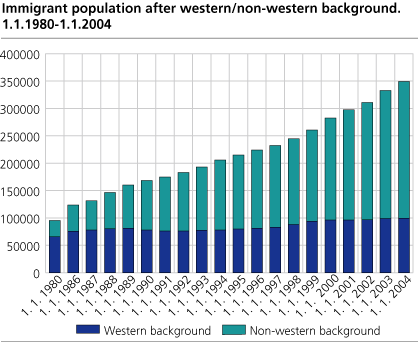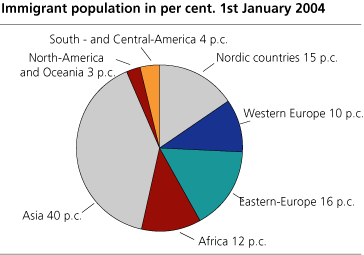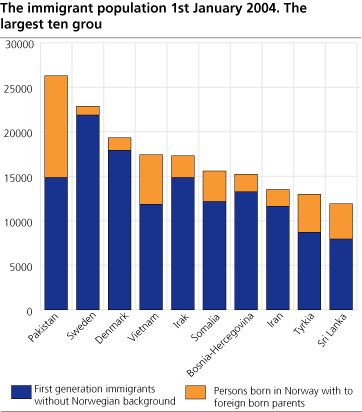Content
Published:
This is an archived release.
The immigrant population counts 349 000
At the beginning of 2004 the immigrant population in Norway was 349 000 and accounted for 7.6 per cent of the total population. The immigrant population increased by 16 100, or 4.9 per cent, in 2003. In comparison, the entire Norwegian population increased by 25 200.
As of 1 January 2004 the population of first generation immigrants without Norwegian background was 289 000. In addition, 60 000 people born in Norway to two foreign-born parents belong to the immigrant population. First-generation immigrants are people who have immigrated to Norway and were born abroad to parents who were also born abroad.
The number of first-generation immigrants increased by 11 800, or 4.3 per cent. The increase is considerably lower than in 2002, but slightly higher than in 2001, when we look at the absolute figures. The number of people born in Norway to two foreign-born parents increased by 4 300, or 7.8 per cent. This is almost the same level as in the two previous years.
More have non-western background
The immigrant population has changed a lot since 1980. The western immigrant population has increased from 65 000 in 1980 to 99 300 in 2004, while the non-western immigrant population has increased from 29 500 in 1980 to 249 600 in 2004. In 1980, people with non-western background made up 31 per cent of the immigrant population. Now, at the beginning of 2004, the non-western population makes up 72 per cent.
Looking at the origin of the immigrant population, the majority are from Asia (40 per cent), followed by people from Eastern Europe (16 per cent), the Nordic countries (15 per cent), Africa (12 per cent) and Western Europe (10 per cent).
Majority from Pakistan
People from Pakistan make up the majority of the immigrant population, (26 300), followed by those with background from Sweden with (22 900), Denmark (19 300), Vietnam (17 400) and Iraq (17 300).
If we look at first-generation immigrants as one group, the majority come from Sweden (21 900), followed by Denmark (17 900), Pakistan and Iraq (14 900 each) and Bosnia-Herzegovina (13 300).
|
Ten largest nasjonality groups. First-generation immigrants and persons
born in Norway with two foreign born parents. 1 January 2004 |
| First generation immigrants | Persons born in Norway with two foreign born parents | ||||||||||||||||||||||||||||||||||||||
|---|---|---|---|---|---|---|---|---|---|---|---|---|---|---|---|---|---|---|---|---|---|---|---|---|---|---|---|---|---|---|---|---|---|---|---|---|---|---|---|
| Total | 289 104 | Total | 59 836 | ||||||||||||||||||||||||||||||||||||
| Sweden | 21 890 | Pakistan | 11 412 | ||||||||||||||||||||||||||||||||||||
| Denmark | 17 922 | Vietnam | 5 552 | ||||||||||||||||||||||||||||||||||||
| Pakistan | 14 874 | Turkey | 4 251 | ||||||||||||||||||||||||||||||||||||
| Iraq | 14 856 | Sri Lanka | 3 969 | ||||||||||||||||||||||||||||||||||||
| Bosnia- Herzegovina | 13 271 | Somalia | 3 420 | ||||||||||||||||||||||||||||||||||||
| Somalia | 12 166 | Iraq | 2 439 | ||||||||||||||||||||||||||||||||||||
| Vietnam | 11 862 | Morocco | 2 291 | ||||||||||||||||||||||||||||||||||||
| Iran | 11 634 | India | 2 289 | ||||||||||||||||||||||||||||||||||||
| Germany | 10 515 | Serbia and Montenegro | 2 230 | ||||||||||||||||||||||||||||||||||||
| United Kingdom | 10 325 | Bosnia-Herzegovina | 1 945 | ||||||||||||||||||||||||||||||||||||
For people born in Norway to two foreign-born parents, the majority are of Pakistani background with 11 400. Vietnamese make up the second largest group with 5 600. People with background from Turkey make up 4 300, Sri Lanka 4 000 and Somalia 3 400. People with Swedish and Danish background make up 1 000 and 1 400 people respectively. The reasons why so few people with Swedish or Danish parents are born in Norway compared to other large immigrant groups, are that Swedes and Danes to a larger extent have children with a person of Norwegian origin, and if two Danes or two Swedes become a couple and have children, they are more likely than other groups to move back to their country of origin.
Danes have long duration of residence
There is a huge variation in the duration of residence for the different groups of first-generation immigrants. There are most Danes among those who have lived in Norway for 20 years or longer with 9 650. This accounts for almost 54 per cent of all the Danes in Norway. For the other large first-generation immigrant groups, there were large proportions of Americans (50 per cent), British (48 per cent), Pakistani (38 per cent) Germans (38 per cent) and Finnish (35 per cent) among those who have lived in Norway for 20 years or longer.
At the opposite end, 90 per cent of Afghanis have lived in Norway for less than five years. The corresponding figure for Russians is 70 per cent, Iraqis 69 per cent, Ethiopians 63 per cent, Somalis 60 per cent, Croatians 54 per cent and Thais 53 per cent. In recent years, Russian and Thai women have settled down in Norway following marriage to a Norwegian man, while the other groups mainly have taken residence because of the need for protection or family reunification with people who already have got protection in Norway.
Many Vietnamese with Norwegian citizenship
About 46 per cent of the immigrant population have Norwegian citizenship, but this varies between the different groups. 90 per cent of those with Vietnamese background have Norwegian citizenship. Also among those with origin from Sri Lanka, Pakistan, Morocco and Turkey more than 70 per cent have Norwegian citizenship. There tends to be a large proportion of people with Norwegian citizenship among the non-western group that have been resident in Norway for a long time. There are very few with western backgrounds that have Norwegian citizenship, despite a long time of residence.
Different age composition
The proportion of people aged 60 or over is a lot lower in the immigrant population than in the entire Norwegian population. For people born in Norway to two foreign-born parents this figure is close to 0 per cent for those aged 60 or over. However, there are many children in this group. 35 per cent are younger than 5 years old and 77 per cent are younger than 15 years old. Among the first-generation immigrants there are relatively few children compared with the entire Norwegian population, but there is a far higher proportion for those aged 25-44.
One in five in Oslo belongs to the immigrant population
114 000 of the people that belong to the immigrant population live in Oslo, and this is almost one third of the immigrant population in Norway. The immigrant population accounts for 21.8 per cent of the population in Oslo. The immigrant population with non-western background makes up 17.6 per cent of the population in Oslo and that of western background 4.3 per cent. The largest immigrant groups in Oslo are those with background from Pakistan (19 000), Somalia (7 000), Sweden (6 800) and Sri Lanka (6 700).
Tables:
- Table 1 Five different delimitations of persons with immigration background/foreign background, by citizenship and immigrant category. 1 January 2004
- Table 2 Population 1 January 2003 and 2004 and changes in 2003, by immigrant category
- Table 3 Population by three variants of country background, country of birth and citizenship. 1 January 2004
- Table 4 Population by different grouping of three variants of country background, country of birth and citizenship, 1 January 2004
- Table 5 Immigrant population and persons with other immigrant background, by immigrant category and country of birth. 1 January 2004
- Table 6 Immigrant population and persons with other immigration background, by immigrant category and age groups. 1 January 2004
- Table 7 Population, by country background. 1970-2004. Foreign country background refers to immigrant population
- Table 8 Population, by Norwegian1. 1 January 2004
- Table 9 Population, by age, sex and immigrant population's country of birth. 1 January 2004
- Table 10 Population by marital status, immigrant populations country of birth and sex. 1 January 2004
- Table 11 Immigrant population by country background. Municipality. Classified by size of immigrant population. 1 January 2004
- Table 12 Immigrant population by country background. County. 1 January 2004
- Table 13 Immigrant population by country of birth, (largest groups). Selected municipalities. 1 January 2004
- Table 14 Immigrant population, by five groups of country background. Urban districts of Oslo. 1 January 2004
- Table 15 Immigrant population by fife groups of country background and age . Urban districts of Oslo. 1 January 2004
- Table 16 First generation immigrants, by length of stay2 . 1 January 2004
Additional information
Contact
-
Oppdrag innvandring
E-mail: oppdraginnvandring@ssb.no
-
Alice Steinkellner
E-mail: alice.steinkellner@ssb.no
tel.: (+47) 90 72 90 51
-
Statistics Norway's Information Centre
E-mail: informasjon@ssb.no
tel.: (+47) 21 09 46 42



